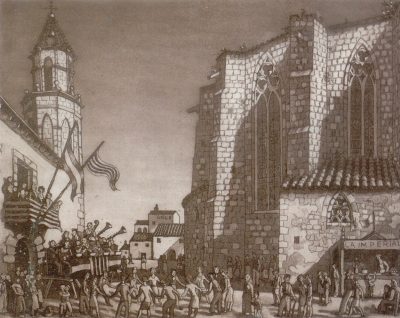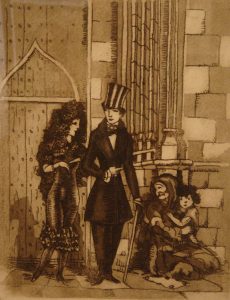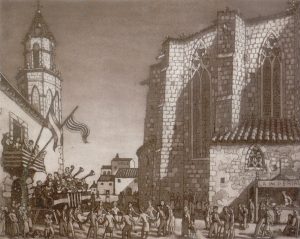Between 1936 and 1939, Josep Aragay primarily focused his efforts on etching, producing over thirty plates. His etchings portrayed customary themes, such as Jugadors de Cartes (Card Players, 1936), Festa Major (Local fiesta, 1937), L’infant i el gos (The child and the dog, 1937) and Obsessió quadricular (Squared obsession, 1937). He also produced with a moralistic focus, such as Setmana Santa? (Holy Week?,1937) and Luxúria (Lust, 1937). Other etchings from this period include Autoretrat (Self-portrait, 1937), Serenata crepuscular (Twilight serenade, 1937), Pagesos i soldats (Peasants and soldiers, 1937), Camperol (Countryman, 1938), Banyista (Bather, 1938) and Amazones (Amazon, 1938).
Aragay displayed some of his work at the 1938 Illustration and Engraving Exhibition, alongside etchings by Xavier Nogués, drawings by the sculptor Josep Clarà and pieces by Josep Granyer and Josep Obiols, among many others. Thanks to this exhibition, critics agreed that Xavier Nogués and Josep Aragay were “great etchers”. Under the Romanesque paintings conserved in the old Church of Santa Maria, Aragay’s etchings are exhibited in the most iconic spot of the museum.
NOTABLE ETCHINGS
Setmana Santa? (Holy Week?), 1937
Made in 1937, Setmana Santa? is an etching with a strong moralistic focus, but also with a strong component of social criticism. Within the context shaped by the Civil War, Aragay highlights the differences between the social classes, depicting a wealthy couple beside a mother and her child begging for charity at the church door. A councillor on Breda Town Council, Aragay had supported the laws put forward by the government of the Second Republic. After the war, he was arrested and sent to prison.
Festa Major (Local Fiesta), 1937
Etched in 1937, Festa Major depicts local customs. Aragay portrays people dancing the traditional sardana in the town’s main square. The musicians of the traditional copla song, the dancers and the people who fill the square are reminiscent of the characters that Aragay drew in the satirical magazines that he contributed to. The scene faithfully depicts the façade of the Town Council building and the Gothic apse of the church. Breda’s landscapes were a recurring theme for the artist.
Between 1936 and 1939, Josep Aragay primarily focused his efforts on etching, producing over thirty plates. His etchings portrayed customary themes, such as Jugadors de Cartes (Card Players, 1936), Festa Major (Local fiesta, 1937), L’infant i el gos (The child and the dog, 1937) and Obsessió quadricular (Squared obsession, 1937). He also produced with a moralistic focus, such as Setmana Santa? (Holy Week?,1937) and Luxúria (Lust, 1937). Other etchings from this period include Autoretrat (Self-portrait, 1937), Serenata crepuscular (Twilight serenade, 1937), Pagesos i soldats (Peasants and soldiers, 1937), Camperol (Countryman, 1938), Banyista (Bather, 1938) and Amazones (Amazon, 1938).
Aragay displayed some of his work at the 1938 Illustration and Engraving Exhibition, alongside etchings by Xavier Nogués, drawings by the sculptor Josep Clarà and pieces by Josep Granyer and Josep Obiols, among many others. Thanks to this exhibition, critics agreed that Xavier Nogués and Josep Aragay were “great etchers”. Under the Romanesque paintings conserved in the old Church of Santa Maria, Aragay’s etchings are exhibited in the most iconic spot of the museum.
NOTABLE ETCHINGS
Setmana Santa? (Holy Week?), 1937
Made in 1937, Setmana Santa? is an etching with a strong moralistic focus, but also with a strong component of social criticism. Within the context shaped by the Civil War, Aragay highlights the differences between the social classes, depicting a wealthy couple beside a mother and her child begging for charity at the church door. A councillor on Breda Town Council, Aragay had supported the laws put forward by the government of the Second Republic. After the war, he was arrested and sent to prison.
Festa major, Josep Aragay, 1937. Etching. Josep Aragay Municipal Museum. Breda.
Festa Major (Local Fiesta), 1937
Etched in 1937, Festa Major depicts local customs. Aragay portrays people dancing the traditional sardana in the town’s main square. The musicians of the traditional copla song, the dancers and the people who fill the square are reminiscent of the characters that Aragay drew in the satirical magazines that he contributed to. The scene faithfully depicts the façade of the Town Council building and the Gothic apse of the church. Breda’s landscapes were a recurring theme for the artist.
Setmana Santa?, Josep Aragay, 1937. Etching. Josep Aragay Municipal Museum. Breda.





